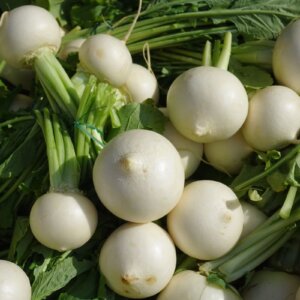Table of Contents
Watermelon rinds are generally compostable materials. Inclusion of these fruit scraps will improve microbial development in the pile due to the rinds’ nitrogen content. Be aware, however, that watermelon rinds contribute significant moisture and are packed with sugars that can attract pests.
If prepared correctly, essential nutrients like calcium, potassium, and phosphorus will further boost the nourishment in your finished compost.

Adding dried leaves, or shredded unbleached papers is necessary to offset the moisture content in watermelon rinds. Failure to maintain balanced moisture levels will lead to anaerobic decomposition, making the compost smell.
Learn more about the process of composting watermelon rinds below and other sustainable alternatives to composting.
How to Compost Watermelon Rinds
Enjoy watermelons as a refreshing snack in summer months, but don’t let the bulky rinds fill up your waste bin. Instead of sending these rinds to landfills where they contribute to methane gas production, try home composting. This sustainable disposal method can nourish your flower beds and vegetable gardens.
You can compost all parts of the watermelon — the pink flesh, pale rinds, and skin. But if you intend to compost leftover seeds, bear in mind they may survive the composting process, and appear in your garden when you apply the finished compost.
To prevent accidental watermelon growth from these lingering seeds, only add them to hot compost piles. The heat from these piles should be sufficient to kill the seeds.
Preparing Watermelon Rinds for Composting
To start composting, examine your watermelon rinds and remove any nonbiodegradable stickers or tags. Manufacturers often make these labels from vinyl and a thin layer of plastic, which doesn’t decompose like organic materials.
Chop your watermelon rinds into small pieces using a kitchen knife. Doing this step will save you precious time as smaller pieces decompose faster. A whole watermelon has a significantly slower decomposition rate.
Because watermelon rinds have a high moisture content, balance them with carbon-rich brown materials in your compost heap. Following the optimal composting conditions is key to yield the best compost quality.
Optimal Composting Conditions for Watermelon Rinds
Treat watermelon rinds as nitrogen-rich green ingredients in your compost mix.
Strive for the ideal carbon to nitrogen ratio of 30:1. Offset the moisture in watermelon rinds with carbon-rich brown ingredients such as dry leaves, shredded unbleached paper, and untreated sawdust. Fruit wastes and vegetable scraps are green materials and should be layered evenly to foster favorable conditions for composting microorganisms.
Be aware: Watermelon rinds can throw off the pile’s moisture levels. Because watermelon is mainly comprised of liquid, it can introduce excess moisture to your compost. If your bin or pile becomes too wet, integrate more carbon-rich materials and aerate the pile by turning.
Keep your compost pile damp, but not soggy. Anaerobic decomposition — linked to unpleasant smells — can occur from excess water.
In hot piles, aim for the optimal temperature range of 90 to 140 degrees Fahrenheit. Regular turning of your compost will improve oxygen circulation, promoting microbial activity and consequently raising its temperature. If you’re including watermelon seeds, the pile’s temperature should at least reach 145 degrees Fahrenheit. You can easily monitor the internal temperature by using a long-stemmed outdoor thermometer.
Sustain these conditions to successfully transform watermelon rinds into nutrient-rich soil amendment.
How Long Do Watermelon Rinds Take to Compost?
In a well-maintained pile, watermelon rinds decompose anywhere between six weeks and a few months. Their decomposition rate depends on the pile’s conditions and the size of your rinds.
Some composters even notice watermelon rinds disintegrating in 5 to 7 days under the right conditions.
How Watermelon Rinds Affect the Composting Process
Due to their moisture and nitrogen content, watermelon rinds have a significant impact on the composting process. Mismanagement and immoderate addition of the rinds can trigger some issues.
Impact on Decomposition
Watermelon rinds are dense and tough, making it essential to cut them into small pieces. Doing this step will speed up their decomposition. Adding large chunks of watermelon rinds to your compost can slow their breakdown and potentially hinder proper airflow.
On a related note, watermelon flesh breaks down faster than the leftover rinds.
Microbial Activity
Rich in nitrogen, watermelon rinds boost microbial development in the pile. When combined with carbon, these elements work together to increase the productivity of the pile, turning organic materials into compost.
As above, remove any nonbiodegradable labels from your rinds before composting to protect beneficial microorganisms from unwanted chemicals.
Temperature and Moisture
Ceaseless microbial activity can increase your compost pile’s internal temperature. Inclusion of minimal watermelon rinds will further support such activity.
Nevertheless, steer clear of incorporating too many rinds as the pile can go anaerobic. This condition could slow decomposition and generate unpleasant odors.
If the pile gets too soggy or releases an off-putting smell, add more carbon-rich materials and stir your compost to improve aeration.
Potential Issues With Composting Watermelon Rinds
Mishandling watermelon rinds can present challenges during composting. You can minimize these issues by taking the necessary precautions.
Will Composting Watermelon Rinds Attract Pests?
Composting watermelon rinds might draw pests like ants, flies, and rodents due to sugar residues from the fruit’s red flesh. To reduce this risk, remove any leftover flesh. Covering your compost pile with a sheet or sealing your bin with a lid can also keep these uninvited guests away from the organic waste.
Will Composting Watermelon Rinds Cause Odors?
In a well-managed compost pile, watermelon rinds typically don’t produce foul odors. However, they are prone to anaerobic decomposition due to their abundant moisture content. Prevent this issue by pairing your watermelon rinds with brown compost materials.
Maintaining a balanced ratio of compost materials and regularly aerating the pile can also keep anaerobic conditions at bay.
Methods for Composting Watermelon Rinds
Watermelon wastes can be processed through a few major composting methods.
Hot Composting
Watermelon rinds are excellent for hot composting. They provide trace elements like calcium and phosphorus, that nourish hot piles, along with nitrogen that aids microbial growth. As microorganisms break down organic matter, they consequently produce heat that makes the pile heat up.
To start hot composting, combine your watermelon rind pieces with other nitrogen-rich materials. Layer your compost ingredients, following the 30:1 carbon to nitrogen ratio when building the hot pile. Add more carbon materials as needed to absorb excess moisture. Closely monitor and consistently maintain your hot compost, as this will help produce high-quality compost.
Strive for an optimal temperature range of 90 to 140 degrees Fahrenheit. If the internal temperature of the pile decreases, turn your compost to enhance air circulation.
Watermelon rinds with seeds should be processed in a hotter pile, ideally at least 145 degrees Fahrenheit or higher.
Cold Composting
A more laid-back approach than hot composting, cold composting primarily relies on bacteria, fungi, insects, and other external elements to decompose organic matter. This method suits first-time composters well because it requires minimal effort during the decomposition period.
Cold piles produce finished compost slower due to the absence of heat. Due to the significant amount of time it takes, cold piles with watermelon rinds are prone to pest issues.
To deter pests attracted to the rinds’ high sugar content, consider covering the pile or bin with a metal or wood sheet.
Vermicomposting
Great news — worms can safely eat watermelon rinds. They’ll savor these sweet snacks and produce nutrient-rich, humus-like worm castings for your garden. Worms like red wigglers, red worms, and tiger worms need diverse food sources (in addition to watermelon rinds). Keep your worm farm healthy to continually churn out compost.
Chop your watermelon rinds into smaller pieces so your worm farm can consume them easily. Place the leftover rinds at the bottom of your worm bin to minimize risk of attracting pests, particularly ants and fruit flies.
Bokashi Composting
Composters with limited garden or outdoor space should consider Bokashi composting organic wastes — including watermelon rinds — at home. You can keep a simple Bokashi bin or bucket indoors, which won’t take up much space. Unlike other composting methods, Bokashi encourages anaerobic decomposition — it seals the food waste away from oxygen and ferments them with a Bokashi bran inoculant.
Avoid overflooding your Bokashi bin with liquids. Inclusion of watermelon rinds can contribute to its moisture levels so it’s best to supplement them with carbon materials.
Alternatives to Composting Watermelon Rinds
There are other sustainable options if home composting isn’t feasible for you — including delicious recipes for upcycled watermelon rind treats.
Industrial Composting of Watermelon Rinds
If a home compost isn’t available, consider sending your watermelon rinds and other organic wastes to a commercial composting facility. These centers operate at high temperatures that process compost for industrial and agricultural use.
Contact your local composting center to learn how they accept kitchen scraps like watermelon rinds.
Upcycling Watermelon Rinds
The white parts in watermelon are packed with amino acids, antioxidants, and vitamins. Consuming these can improve your health with anti-inflammatory and anti-aging benefits.
With minimal preparation, you can eat the rinds straight out of the watermelon skin. To make it more interesting, there are a couple of watermelon rind recipes to try.
Pickled Watermelon Rinds
Pickled watermelon rinds make excellent tangy additions to your meals, especially when paired with fried snacks. Start by peeling the green skin from the rind and cutting it in small pieces. Simmer these pieces in water and salt for about five minutes. Then, bring the mixture to a boil and stir in sugar, vinegar, and spices of your choice.
After the pickled rinds have cooled down, transfer them to an air-tight container as storage.
Stir-Fried Watermelon Rinds
Should you ever find yourself short of water chestnuts, don’t worry — watermelon rinds make a great alternative. Simply chop and peel the rinds and add them to your stir-fry. They will readily soak up any liquids or flavorings in your recipe.
Candied Watermelon Rinds
A perfect recipe for sweets lovers, these candied watermelon rinds are easy to make. Start by peeling the leftover rinds and slicing the white parts into thin strips. In a saucepan, combine water and sugar, then add the chopped rinds. Let this mixture cook on low heat for around 40 minutes.
Next, it’s time to bake the rinds. Lay them out on an oven tray or rack, and bake for two hours at 120 degrees Fahrenheit. Enjoy these sweet treats once cool.
Feeding Watermelon Rinds to Chickens and Livestock
It’s safe to feed minimal amounts of watermelon rinds to chickens. Micronutrients will nourish chickens, providing potassium and other minerals to their diet. When feeding the rinds, make sure to chop them into small pieces to avoid choking incidents.
You can also place the rinds near a bird feeder, as other birds will peck at the white, fleshy portions.
Moreover, animals like pigs, cows, and goats can consume watermelon rinds safely, but moderation is key. Watermelon rinds should not serve as the primary food source for farm animals or substitute for typical animal feeds.
Disposal Options for Watermelon Rinds
Correctly dispose of your watermelon rinds when you can’t do any of the options mentioned. Collect the rinds and place them in the appropriate waste bin.
What Watermelon Rinds Shouldn’t Be Composted?
Watermelon rinds are generally suitable for composting.
However, composters and gardeners who want to keep their compost purely organic should separate chemically treated watermelon rinds and explore other disposal options.
Additionally, avoid adding watermelon rinds with nonbiodegradable labels or stickers to your compost heap, as the adhesive and plastic in them contain harmful chemicals. Remove all inorganic components when preparing watermelon rinds for your compost.
Safety and Precautions When Composting Watermelon Rinds
Ensure your watermelon rind compost does not go anaerobic — unless you’re doing Bokashi — to prevent putrid odors and slow decomposition. Maintain optimal composting conditions to efficiently process watermelon waste into usable compost.
Handle watermelon rinds with care. If you are immunocompromised or have respiratory issues, use a face mask and gloves to minimize health risks.
After composting activity, wash your hands in running water with soap.
FAQ
Can I compost watermelon seeds along with the rinds?
Watermelon waste like the rinds and seeds are suitable for composting. If you want to process watermelon seeds, include them in a hot pile. The pile’s temperature should be at least 145 degrees Fahrenheit or higher, as it is sufficiently intense to exterminate the seeds. This action will prevent the accidental growth of watermelon in the pile or in your garden after using the compost.
How can I prevent pests from getting into my composting pile with watermelon rinds?
To minimize risk of pest issues, remove any remnants of the fruit’s pink flesh from your watermelon rinds. You can incorporate the rinds at the bottom center of your compost bin or pile, and enclose your compost with a cover or seal to keep out unwanted visitors.
Can you eat watermelon rinds?
Yes, watermelon rinds are edible and safe for human consumption. You can chew them straight out of the watermelon skin, or use them for other recipes.










































Leave a Reply